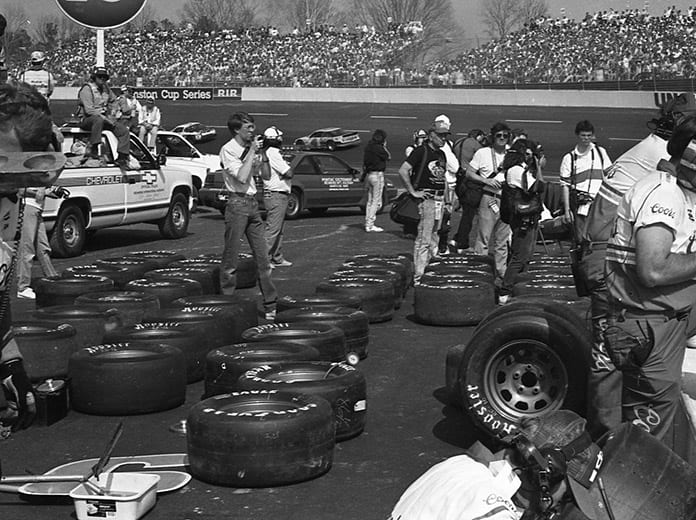
The season began with Bobby Allison winning the Daytona 500 on Goodyears over his son Davey Allison. During the next three weeks, Bonnett drove his Rahmoc Racing Pontiac to two points victories and a win in the exhibition race in Australia riding on Hoosier tires.
“Bob Newton of Hoosier Tire, I’ve known him all my life,” Bonnett said in victory lane at North Carolina Motor Speedway. “When I ran short tracks, I ran his tires a lot. When he told me he was coming Winston Cup racing, I knew he wouldn’t be here playing. I knew he would be trying to win races. He has his whole family involved and I like that. We are running his tires but I told him, ‘The first time Goodyear beats you I’m coming back on their tires.’ But we have too good of a race team to be locked down, but right now, Hoosier is on top of it.”
In April, Speed took Hoosier to victory lane at Darlington. By May, the competition between the two tire manufacturers had reached a difficult point. The tires were not holding up and they caused many crashes during the Coca-Cola 600 at Charlotte Motor Speedway.
Wilson, Ricky Rudd, Harry Gant, Sterling Marlin and Bonnett were victims of blown tires with Rudd, Bonnett and Gant suffering knee, leg and arm injuries. More than 20 drivers blew tires that day before race winner Darrell Waltrip avoided problems to win on Hoosiers for team owner Rick Hendrick.
At Pennsylvania’s Pocono Raceway in late July, all of Goodyear’s 1,100 tires were deemed too wide and illegal, causing a scramble for Hoosier’s tires. It was the first time since the 1956 Southern 500 at Darlington Raceway that Goodyear was not involved in a NASCAR event. Ironically, on the road course at Watkins Glen (N.Y.) Int’l in August, Hoosier had its tires deemed illegal for the same infraction.
Through 1988, teams would often switch brands during races. That meant team owners had to buy and prepare twice as many tires in the event one performed better than the other. All told, drivers won 20 races on Goodyear tires to nine for Hoosier.
As the 1989 season began at Daytona, Goodyear introduced the radial tire to NASCAR. Before the 500 began, Dale Earnhardt and Bill Elliott crashed due to tire failures with Elliott suffering a broken wrist. Goodyear elected to pull its tires from the race, giving Hoosier full reign on bias-ply tires with no failures. Waltrip won his lone Daytona 500 using Hoosier tires.
“Really, to be truthful, I drove both bias-ply and radial in those days and I couldn’t tell a difference,” said Donnie Allison. “They both performed well and I had no problem with either one. The difference was the side walls on the bias-play tires could offer more camber and the radials didn’t do that.”
Earnhardt earned the first victory for Goodyear radial racing tires at North Wilkesboro (N.C.) Speedway in April 1989.
“As soon as the race started, we know we were in Fat City,” Earnhardt said. “The guys who qualified on Hoosiers had to change under the green and lost laps.
“We tested here on the radials and based on what we’d seen, we felt the tires were safe and consistent. I’ve got to hand it to Goodyear in coming back with the radials and proving themselves. They were consistent. All day long we could bank on what the tires would do. The more I ran on them the better I liked them. I would like to see them tested at all of the tracks.”
Newton and Hoosier pulled out of the sport in mid-1989, returned for the ’94 season but left again at year’s end due to a lack of sales. At the start of the season at Daytona, Bonnett and Rodney Orr were killed in separate single-car crashes. Both drivers were using Hoosier tires, but broken shock mounts were believed to have been a contributing factor to what caused their accidents.
Hoosier continued to supply tires in ARCA competition for 25 years before being sold to Continental Tire Corp. in October 2016. Goodyear radials have been used in thousands of NASCAR Cup Series, Xfinity Series and Gander Outdoors Truck Series events since Earnhardt took them to victory lane in 1989. n
